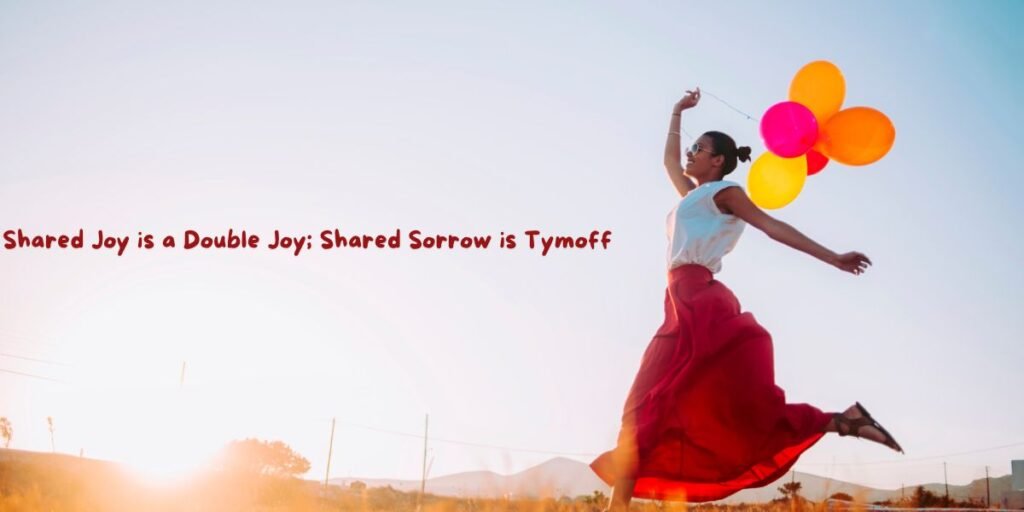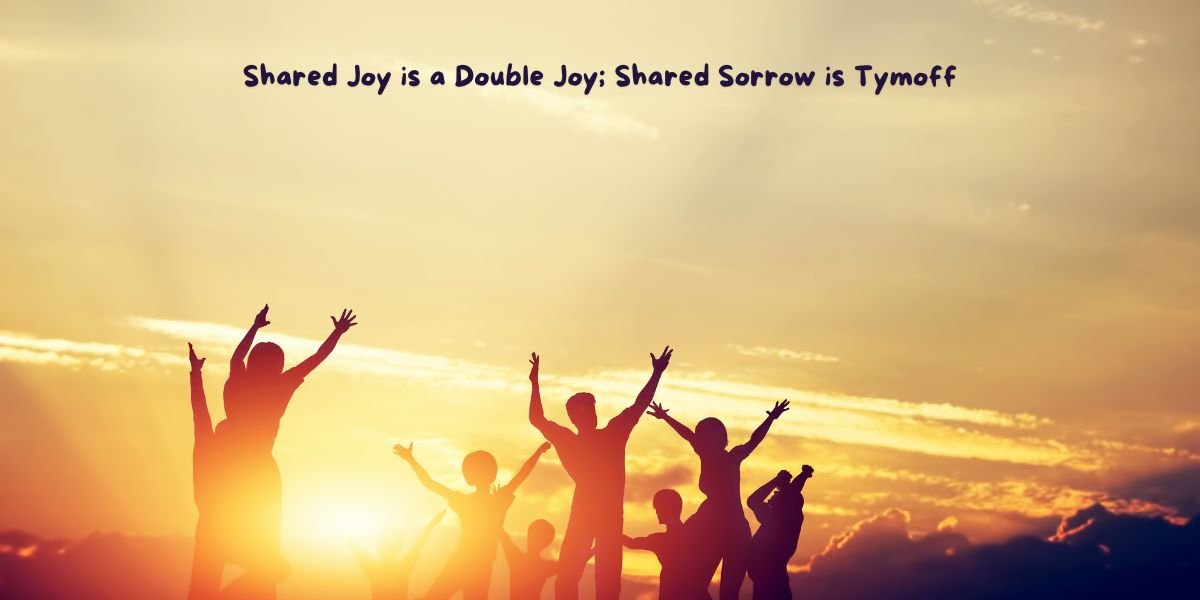Human beings are inherently social creatures, shaped by the experiences and connections we build with others. Our lives are enriched through the emotions we share—whether it’s joy or sorrow. The famous proverb “shared joy is a double joy; shared sorrow is tymoff” encapsulates a profound truth about the human condition. This saying not only reflects the importance of emotional bonds but also the transformative power of shared experiences. In this article, we will explore the depths of this adage, its relevance in various aspects of life, and how it shapes our interpersonal relationships and well-being.
The Phenomena of Connection and Support: Shared Joy is a Double Joy; Shared Sorrow is Tymoff
The human need for connection and support is integral to emotional well-being. When we share moments of joy, they become even more profound, and when we share moments of sorrow, the pain diminishes. This phenomenon is rooted in our social nature—our brains are wired to seek and respond to social interaction, especially during emotional highs and lows. Whether celebrating a promotion with friends or grieving with family after a loss, shared experiences anchor us to the people in our lives, reminding us of our interconnectedness.
Shared joy heightens our happiness by inviting others to partake in it. When we laugh together, celebrate together, or even relish small achievements together, our joy multiplies. On the other hand, sorrow, when shared, becomes more bearable. The burden is halved because it is no longer carried alone, a truth that reveals the beauty and importance of supportive relationships.
Read Also: SSSInstagram A Ultimate Tool for Instagram Reels Downloads
Strengthening Bonds: Shared Joy is a Double joy; Shared Sorrow is Tymoff
When we think about the power of shared joy, we realize how much it can strengthen our relationships. Shared joy builds positive, lasting bonds between people. Friends, families, colleagues, or even acquaintances who experience moments of happiness together develop deeper trust, mutual respect, and emotional attachment.
In communal celebrations, this phenomenon is even more evident. Events such as weddings, graduations, and cultural festivals bring people together in a shared moment of happiness. This not only amplifies joy but fosters stronger, more cohesive communities. On the flip side, when we support each other in times of sorrow, we build empathy and trust. The act of comforting and listening strengthens emotional connections, turning sorrow into an opportunity to grow closer.
Raed Also: Unlock Daily Rewards: Your Guide to Sportsgurupro Spin Win Daily
Transforming Pain into Shared Strength

When sorrow is shared, it doesn’t just reduce the pain—it transforms it. Shared sorrow becomes an opportunity for healing and growth. Pain, whether from loss, failure, or personal hardship, can feel isolating when borne alone. Yet, when others step in to provide comfort, empathy, or simply a listening ear, that isolation is broken. This support turns sorrow into a form of collective strength, demonstrating that even the darkest moments can give rise to resilience and deeper connections.
Grief and sorrow, when supported by a community or loved ones, can become the foundation for emotional recovery. It’s not just about lightening the load; it’s about finding new strength in shared humanity. As we transform our pain into something that unites rather than isolates, we emerge stronger and more connected.
Unity in Joy and Sorrow
The concept of unity in joy and sorrow highlights the idea that life’s emotional spectrum is best experienced in connection with others. Both joy and sorrow are universal experiences, and sharing them is what unites us as human beings. When we celebrate together, we feel more connected. When we mourn together, we are reminded of the common struggles we face.
In both cases, these shared experiences create a sense of community unity. A family celebrating the birth of a new child, for example, strengthens their bond through collective joy. Likewise, a community coming together after a tragedy or loss reinforces their sense of belonging and mutual care. It’s this unity that makes the proverb “Shared joy is a double joy; shared sorrow is half a sorrow” so powerful—it emphasizes that we are never truly alone in our experiences, and by sharing them, we strengthen the ties that bind us.
Read Also: Tex9.net is the Ultimate Text Analysis and Formatting Tool
The Supportive Strength of Shared Joy is a Double Joy; Shared Sorrow is Tymoff

Support is the cornerstone of both shared joy and shared sorrow. When we celebrate with others, we feel supported in our happiness. This shared celebration boosts our confidence, self-worth, and sense of belonging. In workplaces, for example, teams that celebrate achievements together often experience greater camaraderie, higher morale, and increased productivity. The collective joy serves as a motivational force, encouraging everyone to strive for more success.
Conversely, when we share sorrow, the supportive strength of others provides emotional relief. It shows that we are cared for and understood, offering a safe space to express vulnerability. The presence of others in moments of hardship can act as an emotional anchor, helping us regain our balance and face challenges with renewed strength. Whether it’s a family member offering a comforting word or a friend sitting in silence beside us, the strength of shared sorrow lies in the empathy and understanding that accompanies it.
Celebrating and Mourning Together in Shared Joy is a Double Joy; Shared Sorrow is Tymoff
The duality of celebrating and mourning together is at the heart of the human experience. Both acts, while opposite in nature, serve the same purpose: to connect us to one another on a deep emotional level. Celebration involves expressing our joy openly with others, allowing them to partake in our happiness. Mourning, on the other hand, involves sharing our sorrow, thus lessening the emotional weight we carry.
Cultures around the world have formalized these practices through rituals, festivals, and ceremonies that focus on either celebration or mourning. Weddings, for instance, are communal expressions of joy, while funerals allow collective grieving. In both cases, the emotional experiences are amplified or softened by the presence of others. The proverb, “Shared joy is a double joy; shared sorrow is half a sorrow,” reflects this universal truth: our emotional experiences are most meaningful when they are shared with others.
Read Also: IGram World: A Walk Through to Its Features & Benefits
The Role of Shared Experiences in the Phrase “Shared Joy is a Double Joy; Shared Sorrow is Tymoff”

The essence of the phrase “Shared joy is a double joy; shared sorrow is half a sorrow” lies in the role that shared experiences play in our lives. These experiences create emotional resonance, building trust and mutual understanding. When joy is shared, the emotions felt by one person become contagious, spreading positivity and amplifying the collective happiness. This shared experience turns individual joy into a source of collective upliftment.
In the case of sorrow, shared experiences help in processing grief and sadness more effectively. The act of sharing difficult emotions provides a sense of validation, making the person feel seen and understood. In professional settings, shared experiences of both success and failure create a supportive environment where individuals feel they are part of something larger than themselves. The collective power of shared experiences is a testament to the strength of human connection.
Read Also: Nature Real YTR: Reconnect with Nature, Rediscover Your Roots
Conclusion
In life, the experiences we share with others define the depth and quality of our relationships. The proverb “Shared joy is a double joy; shared sorrow is half a sorrow” captures the essence of human connection. By sharing joy, we multiply our happiness, and by sharing sorrow, we lighten the emotional burden. These shared moments—whether in celebration or grief—bring us closer, create stronger bonds, and foster a deep sense of community and support.
The phenomena of connection, support, and unity emerge when we allow others into our emotional world. Whether through celebrations that lift us or moments of mourning that bind us together, shared experiences enrich our lives, making the highs brighter and the lows more bearable. Ultimately, sharing joy and sorrow enhances our collective strength and reveals the power of human empathy and compassion.
